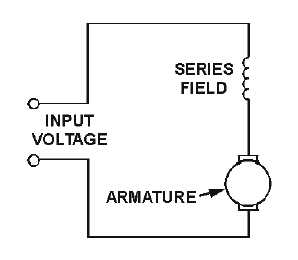2-5
Figure 2-3.—Series-wound dc motor.
This type of motor develops a very large amount of turning force, called torque, from a standstill.
Because of this characteristic, the series dc motor can be used to operate small electric appliances,
portable electric tools, cranes, winches, hoists, and the like.
Another characteristic is that the speed varies widely between no-load and full-load. Series motors
cannot be used where a relatively constant speed is required under conditions of varying load.
A major disadvantage of the series motor is related to the speed characteristic mentioned in the last
paragraph. The speed of a series motor with no load connected to it increases to the point where the motor
may become damaged. Usually, either the bearings are damaged or the windings fly out of the slots in the
armature. There is a danger to both equipment and personnel. Some load must ALWAYS be connected to
a series motor before you turn it on. This precaution is primarily for large motors. Small motors, such as
those used in electric hand drills, have enough internal friction to load themselves.
A final advantage of series motors is that they can be operated by using either an ac or dc power
source. This will be covered in the chapter on ac motors.
Q7. What is the main disadvantage of a series motor?
Q8. What is the main advantage of a series motor?
SHUNT MOTOR
A shunt motor is connected in the same way as a shunt generator. The field windings are connected
in parallel (shunt) with the armature windings. The circuit for a shunt motor is shown in figure 2-4.



